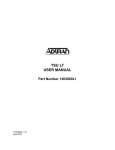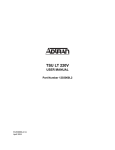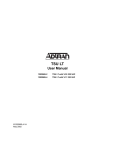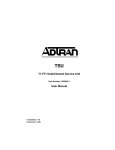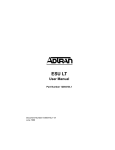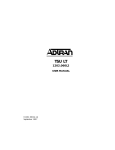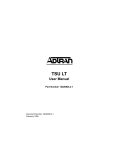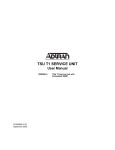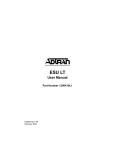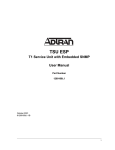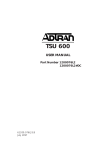Download ADTRAN 1202295L1 User manual
Transcript
TSU ACE USER MANUAL Part Number 1202295L1 61202295L1-1A April 2003 Trademarks TSU ACE User Manual Trademarks Any brand names and product names included in this manual are trademarks, registered trademarks, or trade names of their respective holders. T-Watch PRO® is a registered trademark of ADTRAN, Inc. To the Holder of the Manual The contents of this manual are current as of the date of publication. ADTRAN reserves the right to change the contents without prior notice. In no event will ADTRAN be liable for any special, incidental, or consequential damages or for commercial losses even if ADTRAN has been advised thereof as a result of issue of this publication. About this Manual This manual provides a complete description of the TSU ACE system and system software. The purpose of this manual is to provide the technician, system administrator, and manager with general and specific information related to the planning, installation, operation, and maintenance of the TSU ACE. This manual is arranged so that needed information can be quickly and easily found. 901 Explorer Boulevard P.O. Box 140000 Huntsville, AL 35814-4000 Phone: (256) 963-8000 © 2003 ADTRAN, Inc. All Rights Reserved. Printed in U.S.A. 2 © 2003 ADTRAN, Inc. 61202295L1-1A TSU ACE User Manual Revision History Revision History Document Revision Date A April 2003 Description of Changes Initial release of new part number. B C D E F G Conventions Notes provide additional useful information. Cautions signify information that could prevent service interruption. Warnings provide information that could prevent damage to the equipment or endangerment to human life. 61202295L1-1A © 2003 ADTRAN, Inc. 3 Safety Instructions TSU ACE User Manual Safety Instructions When using your telephone equipment, please follow these basic safety precautions to reduce the risk of fire, electrical shock, or personal injury: 1. Do not use this product near water, such as a bathtub, wash bowl, kitchen sink, laundry tub, in a wet basement, or near a swimming pool. 2. Avoid using a telephone (other than a cordless-type) during an electrical storm. There is a remote risk of shock from lightning. 3. Do not use the telephone to report a gas leak in the vicinity of the leak. 4. Use only the power cord, power supply, and/or batteries indicated in the manual. Do not dispose of batteries in a fire. They may explode. Check with local codes for special disposal instructions. 5. The socket-outlet shall be installed near the equipment and shall be easily accessible. Double pole/neutral fusing. Save These Important Safety Instructions 4 © 2003 ADTRAN, Inc. 61202295L1-1A TSU ACE User Manual Compliance Information Compliance Information Product: Model Numbers: FCC Registration Number: TSU ACE 1202295L1 US: HDCDENAN1203060L1 FCC regulations require that the following information be provided to the customer: 1. This equipment complies with Part 68 of the FCC rules. On the side or bottom of this equipment is a label that contains, among other information, the FCC Registration Number and Ringer Equivalence Number (REN), if applicable, for this equipment. If required, this information must be given to the telephone company. 2. An FCC-compliant telephone cord and modular plug is provided with this equipment. This equipment is designed to be connected to the telephone network or premises wiring using a compatible modular jack which is Part 68-compliant. See installation instructions for details. 3. If your telephone equipment causes harm to the telephone network, the telephone company may discontinue your service temporarily. If possible, they will notify you in advance. But if advance notice isn’t practical, you will be notified as soon as possible. You will be advised of your right to file a complaint with the FCC. 4. Your telephone company may make changes in its facilities, equipment, operations, or procedures that could affect the proper operation of your equipment. If they do, you will be given advance notice to give you an opportunity to maintain uninterrupted service. 5. If you experience trouble with this equipment, please contact ADTRAN at (256) 963-8722 for repair/warranty information. The telephone company may ask you to disconnect this equipment from the network until the problem has been corrected or until you are sure the equipment is not malfunctioning. 6. This unit contains no user-serviceable parts. 7. The FCC recommends that the AC outlet to which equipment requiring AC power is to be installed is provided with an AC surge arrester. 8. The REN is used to determine the quantity of devices which may be connected to the telephone line. Excessive RENs on the telephone line may result in the devices not ringing in response to an incoming call. In most, but not all areas, the sum of RENs should not exceed five (5.0). To be certain of the number of devices that may be connected to a line, as determined by the total RENs, contact the local telephone company. 9. The following information may be required when applying to your local telephone company for leased line facilities. Service Type 61202295L1-1A REN/SOC FIC USOC 1.544 Mbps - SF 6.0 F 04DU9-BN RJ-48C 1.544 Mbps - SF and B8ZS 6.0 F 04DU9-DN RJ-48C 1.544 Mbps - ESF 6.0 F 04DU9-1KN RJ-48C 1.544 Mbps - ESF and B8ZS 6.0 F 04DU9-1SN RJ-48C © 2003 ADTRAN, Inc. 5 Federal Communications Commission Radio Frequency Interference Statement TSU ACE User Manual Federal Communications Commission Radio Frequency Interference Statement This equipment has been tested and found to comply with the limits for a Class A digital device, pursuant to Part 15 of the FCC Rules. These limits are designed to provide reasonable protection against harmful interference when the equipment is operated in a commercial environment. This equipment generates, uses, and can radiate radio frequency energy and, if not installed and used in accordance with the instruction manual, may cause harmful interference to radio frequencies. Operation of this equipment in a residential area is likely to cause harmful interference in which case the user will be required to correct the interference at his own expense. Shielded cables must be used with this unit to ensure compliance with Class A FCC limits. Changes or modifications to this unit not expressly approved by the party responsible for compliance could void the user’s authority to operate the equipment. Affidavit Requirements for Connection to Digital Services • An affidavit is required to be given to the telephone company whenever digital terminal equipment without encoded analog content and billing protection is used to transmit digital signals containing encoded analog content which are intended for eventual conversion into voiceband analog signals and transmitted on the network. • The affidavit shall affirm that either no encoded analog content or billing information is being transmitted or that the output of the device meets Part 68 encoded analog content or billing protection specifications. • End user/customer will be responsible for filing an affidavit with the local exchange carrier when connecting unprotected customer premise equipment (CPE) to 1.544 Mbps or subrate digital services. • Until such time as subrate digital terminal equipment is registered for voice applications, the affidavit requirement for subrate services is waived. 6 © 2003 ADTRAN, Inc. 61202295L1-1A TSU ACE User Manual Affidavit for Connection of Customer Premises Equipment Affidavit for Connection of Customer Premises Equipment to 1.544 Mbps and/or Subrate Digital Services For the work to be performed in the certified territory of ___________________ (telco name) State of ________________ County of ________________ I, _______________________ (name), ____________________________________ (business address), ____________________ (telephone number) being duly sworn, state: I have responsibility for the operation and maintenance of the terminal equipment to be connected to 1.544 Mbps and/or ________ subrate digital services. The terminal equipment to be connected complies with Part 68 of the FCC rules except for the encoded analog content and billing protection specifications. With respect to encoded analog content and billing protection: ( ) I attest that all operations associated with the establishment, maintenance, and adjustment of the digital CPE with respect to analog content and encoded billing protection information continuously complies with Part 68 of the FCC Rules and Regulations. ( ) The digital CPE does not transmit digital signals containing encoded analog content or billing information which is intended to be decoded within the telecommunications network. ( ) The encoded analog content and billing protection is factory set and is not under the control of the customer. I attest that the operator(s)/maintainer(s) of the digital CPE responsible for the establishment, maintenance, and adjustment of the encoded analog content and billing information has (have) been trained to perform these functions by successfully having completed one of the following (check appropriate blocks): ( ) A. A training course provided by the manufacturer/grantee of the equipment used to encode analog signals; or ( ) B. A training course provided by the customer or authorized representative, using training materials and instructions provided by the manufacturer/grantee of the equipment used to encode analog signals; or ( ) C. An independent training course (e.g., trade school or technical institution) recognized by the manufacturer/grantee of the equipment used to encode analog signals; or ( ) D. In lieu of the preceding training requirements, the operator(s)/maintainer(s) is (are) under the control of a supervisor trained in accordance with _________ (circle one) above. 61202295L1-1A © 2003 ADTRAN, Inc. 7 Affidavit for Connection of Customer Premises Equipment TSU ACE User Manual I agree to provide ______________________ (telco’s name) with proper documentation to demonstrate compliance with the information as provided in the preceding paragraph, if so requested. _________________________________Signature _________________________________Title _________________________________ Date Transcribed and sworn to before me This ________ day of _______________, _______ _________________________________ Notary Public My commission expires: _________________________________ 8 © 2003 ADTRAN, Inc. 61202295L1-1A TSU ACE User Manual Industry Canada Compliance Information Industry Canada Compliance Information Notice: The Industry Canada label applied to the product (identified by the Industry Canada logo or the “IC:” in front of the certification/registration number) signifies that the Industry Canada technical specifications were met. Notice: The Ringer Equivalence Number (REN) for this terminal equipment is supplied in the documentation or on the product labeling/markings. The REN assigned to each terminal device indicates the maximum number of terminals that can be connected to a telephone interface. The termination on an interface may consist of any combination of devices subject only to the requirement that the sum of the RENs of all the devices should not exceed five (5). Canadian Emissions Requirements This digital apparatus does not exceed the Class A limits for radio noise emissions from digital apparatus as set out in the interference-causing equipment standard entitled “Digital Apparatus,” ICES-003 of the Department of Communications. Cet appareil numérique respecte les limites de bruits radioelectriques applicables aux appareils numériques de Class A prescrites dans la norme sur le materiel brouilleur: “Appareils Numériques,” NMB-003 edictee par le ministre des Communications. 61202295L1-1A © 2003 ADTRAN, Inc. 9 Warranty TSU ACE User Manual Warranty ADTRAN will replace or repair this product within the warranty period if it does not meet its published specifications or fails while in service. Warranty information can be found at www.adtran.com/warranty. Product Registration Registering your product helps ensure complete customer satisfaction. Please take time to register your products on line at www.adtran.com. Click Service/Support on the top of the page, and then click Product Registration under Support. Customer Service, Product Support Information, and Training ADTRAN will replace or repair this product within the warranty period if it does not meet its published specifications or fails while in service. Warranty information can be found at www.adtran.com/warranty. A return material authorization (RMA) is required prior to returning equipment to ADTRAN. For service, RMA requests, training, or more information, use the contact information given below. Repair and Return If you determine that a repair is needed, please contact our Customer and Product Service (CAPS) department to have an RMA number issued. CAPS should also be contacted to obtain information regarding equipment currently in house or possible fees associated with repair. CaPS Department (256) 963-8722 Identify the RMA number clearly on the package (below address), and return to the following address: ADTRAN Customer and Product Service 901 Explorer Blvd. (East Tower) Huntsville, Alabama 35806 RMA # _____________ Pre-Sales Inquiries and Applications Support Your reseller should serve as the first point of contact for support. If additional pre-sales support is needed, the ADTRAN Support web site provides a variety of support services such as a searchable knowledge base, latest product documentation, application briefs, case studies, and a link to submit a question to an Applications Engineer. All of this, and more, is available at: http://support.adtran.com When needed, further pre-sales assistance is available by calling our Applications Engineering Department. Applications Engineering (800) 615-1176 10 © 2003 ADTRAN, Inc. 61202295L1-1A TSU ACE User Manual Customer Service, Product Support Information, and Training Post-Sale Support Your reseller should serve as the first point of contact for support. If additional support is needed, the ADTRAN Support web site provides a variety of support services such as a searchable knowledge base, updated firmware releases, latest product documentation, service request ticket generation and troubleshooting tools. All of this, and more, is available at: http://support.adtran.com When needed, further post-sales assistance is available by calling our Technical Support Center. Please have your unit serial number available when you call. Technical Support (888) 4ADTRAN Installation and Maintenance Support The ADTRAN Custom Extended Services (ACES) program offers multiple types and levels of installation and maintenance services which allow you to choose the kind of assistance you need. This support is available at: http://www.adtran.com/aces For questions, call the ACES Help Desk. ACES Help Desk (888) 874-ACES (2237) Training The Enterprise Network (EN) Technical Training Department offers training on our most popular products. These courses include overviews on product features and functions while covering applications of ADTRAN's product lines. ADTRAN provides a variety of training options, including customized training and courses taught at our facilities or at your site. For more information about training, please contact your Territory Manager or the Enterprise Training Coordinator. 61202295L1-1A Training Phone (800) 615-1176, ext. 7500 Training Fax (256) 963-6700 Training Email [email protected] © 2003 ADTRAN, Inc. 11 Customer Service, Product Support Information, and Training 12 © 2003 ADTRAN, Inc. TSU ACE User Manual 61202295L1-1A Table of Contents Chapter 1 Introduction ...........................................................................................................19 TSU ACE Overview ....................................................................................................................................................19 TSU ACE Physical Description ............................................................................................................................19 TSU ACE Features ...............................................................................................................................................20 TSU ACE Interfaces .............................................................................................................................................20 TSU ACE Bridge/Router Application .........................................................................................................................20 Chapter 2 Inspection and Installation ...................................................................................21 TSU ACE Shipment .....................................................................................................................................................21 Inspecting for Damages ........................................................................................................................................21 Shipping Contents .................................................................................................................................................21 Installing the TSU ACE ...............................................................................................................................................21 Power Connection .................................................................................................................................................21 Grounding Instructions .........................................................................................................................................21 TSU ACE Rear Panel ...........................................................................................................................................23 TSU ACE Interfaces .............................................................................................................................................23 Power Up Testing & Initialization ...............................................................................................................................24 Self-Test ................................................................................................................................................................24 Chapter 3 Operation ................................................................................................................25 Front Panel ...................................................................................................................................................................25 LCD Window ...............................................................................................................................................................26 Main Menus .................................................................................................................................................................26 Status .....................................................................................................................................................................27 Config (Configuration) .........................................................................................................................................27 Util (Utility) ..........................................................................................................................................................28 Test ........................................................................................................................................................................28 Example Menu Operations ...........................................................................................................................................29 Selecting a Main Menu Item .................................................................................................................................29 Selecting a Submenu .............................................................................................................................................30 Setting Data Fields ................................................................................................................................................30 Viewing Display-Only Data Fields .......................................................................................................................30 Exiting Any Menu Field Operation or Display ....................................................................................................30 Alternate Method of Control for TSU ACE .................................................................................................................31 T-Watch PRO Management Software Program ...................................................................................................31 Chapter 4 Status Menu ............................................................................................................33 NI Perf Rpts menu ........................................................................................................................................................33 Curr Err/Alm Menu ......................................................................................................................................................34 Err/Alm Hist Menu ......................................................................................................................................................35 Chapter 5 Config Menu ...........................................................................................................37 Network (NI) Menu .....................................................................................................................................................37 61202295L1-1A © 2003 ADTRAN, Inc. 13 Table of Contents TSU ACE User Manual Clock Sources and Timing ....................................................................................................................................38 Port Menu .....................................................................................................................................................................40 Chapter 6 Utility Menu ...........................................................................................................43 Software Rev ................................................................................................................................................................43 Reinit Unit ....................................................................................................................................................................43 Address .........................................................................................................................................................................43 Set Passcode .................................................................................................................................................................44 Keypad .........................................................................................................................................................................44 Fact Restore ..................................................................................................................................................................44 Chapter 7 Test Menu ...............................................................................................................45 Network Tests ..............................................................................................................................................................45 Local Loopback ....................................................................................................................................................46 Remote Loopback .................................................................................................................................................46 Test Pattern ...........................................................................................................................................................47 CLR Errors ............................................................................................................................................................47 Insert 511 Errors ...................................................................................................................................................47 Run Self-Test ...............................................................................................................................................................47 Port Tests ......................................................................................................................................................................48 Chapter 8 Circuit Testing .......................................................................................................49 Far End Looped Back Test ...........................................................................................................................................49 Appendix A TSU ACE Menu Tree ..........................................................................................51 Appendix B DTE Data Rate Chart..........................................................................................53 Appendix C Pinouts...................................................................................................................55 Network (USOC RJ-48C) ............................................................................................................................................55 Nx56K/64K DTE (V.35) ..............................................................................................................................................56 14 © 2003 ADTRAN, Inc. 61202295L1-1A List of Figures Figure 1-1. TSU ACE - Front Panel .......................................................................................................19 Figure 1-2. TSU ACE - Rear Panel ........................................................................................................19 Figure 1-3. Simple Bridge Application on a T1 or an FT1 Circuit ........................................................20 Figure 2-1. TSU ACE Rear Panel ..........................................................................................................23 Figure 2-2. TSU ACE Interfaces ............................................................................................................23 Figure 3-1. TSU ACE Front Panel .........................................................................................................25 Figure 3-2. TSU ACE Main Menu Screen .............................................................................................26 Figure 3-3. TSU ACE Main Menus .......................................................................................................27 Figure 3-4. Cursor on Menu Item ..........................................................................................................29 Figure 3-5. Submenu Fields ...................................................................................................................29 Figure 3-6. Using T-Watch PRO ...........................................................................................................31 Figure 4-1. Status Menu Tree .................................................................................................................33 Figure 4-2. Severely Errored Seconds Screen ........................................................................................34 Figure 4-3. Loss of Signal (Current Errors/Alarms) Screen ..................................................................34 Figure 4-4. Clear History Screen ...........................................................................................................35 Figure 5-1. Configuration Menu Tree ....................................................................................................37 Figure 5-2. Network Submenu ...............................................................................................................38 Figure 5-3. Network Timed Clock Source .............................................................................................39 Figure 5-4. DTE Clock Source ...............................................................................................................39 Figure 5-5. Internal Clock Source ..........................................................................................................40 Figure 5-6. Inband Remote Configuration .............................................................................................42 Figure 6-1. Utility Menu Tree ................................................................................................................43 Figure 6-2. Address Screen ....................................................................................................................44 Figure 7-1. Test Menu Tree ...................................................................................................................45 Figure 7-2. Network Loopback Tests .....................................................................................................46 Figure 7-3. Self Test Results Screen ......................................................................................................47 Figure 7-4. Port Loopback Tests ............................................................................................................48 Figure A-1. TSU ACE Menu Tree (Status and Config) .............................................................................51 Figure A-2. TSU ACE Menu Tree (Util and Test).....................................................................................52 61202295L1-1A © 2003 ADTRAN, Inc. 15 List of Figures 16 TSU ACE User Manual © 2003 ADTRAN, Inc. 61202295L1-1A List of Tables Table 1-1. Table 2-1. Table 3-1. Table 3-2. Table 4-1. Table 4-2. Table 5-1. Table 5-2. Table B-1. Table C-1. Table C-2. TSU Family of Single-port CSU/DSUs ................................................................................. 19 Number Identification for TSU ACE Rear Panel .................................................................. 23 Number Identification for TSU ACE Front Panel ................................................................. 25 LCD Features ......................................................................................................................... 26 Network Interface Performance Reports (15 Min / 24 Hours) .............................................. 34 Alarms and Errors (Current and Historical)........................................................................... 35 Network Interface Submenus................................................................................................. 38 Normal Mode Operation ........................................................................................................ 42 DTE Data Rate Chart ..............................................................................................................53 Network Pin Assignments.......................................................................................................55 V.35 Pin Assignment ..............................................................................................................56 61202295L1-1A © 2003 ADTRAN, Inc. 17 List of Tables 18 TSU ACE User Manual © 2003 ADTRAN, Inc. 61202295L1-1A Introduction Chapter 1 TSU ACE OVERVIEW The TSU ACE belongs to the ADTRAN T1 single-port CSU/DSU family offering complete flexibility in connecting various data sources to T1 or FT1 facilities (see Table 1-1). Table 1-1. TSU Family of Single-port CSU/DSUs Product Description TSU ACE T1 CSU/DSU with a single Nx56/64K serial port that offers front panel configuration only. TSU LT T1 CSU/DSU with a single Nx56/64K serial port that offers terminal, front panel, or T-Watch PRO configuration options. The TSU ACE serves as the link between user data sources such as local area network (LAN) bridges and routers, computers, CAD systems, and teleconferencing equipment. The amount of bandwidth allocated to the port is custom programmable. The data terminal equipment (DTE) data can occupy contiguous or alternate channels in the T1 stream, and the channels may start at any position. TSU ACE Physical Description Figure 1-1 shows the TSU ACE front panel and Figure 1-2 shows the rear panel. . Figure 1-1. TSU ACE - Front Panel V.35 Nx56/64 115VAC 60HZ 0.15A NETWORK Figure 1-2. TSU ACE - Rear Panel 61202295L1-1A © 2003 ADTRAN, Inc. 19 Chapter 1 Introduction TSU ACE User Manual TSU ACE Features • • • • • Easy configuration capabilities using simplistic menus displayed in a liquid crystal display (LCD) window operated by a front panel keypad. Timing is selectable from the network, the Nx56/64 DTE port, or internally. Variety of test patterns: all ones, all zeros, 511, and 1:8 Extensive self-testing and monitoring ensures proper operation. Flexible channel allocation (any starting channel and alternate or contiguous). TSU ACE Interfaces The TSU ACE is equipped with two interfaces: • • Network DS1 interface per AT&T 62411 Nx56/64 serial V.35 TSU ACE BRIDGE/ROUTER APPLICATION A bridge or router can be interfaced to the network by using the V.35 DTE interface. The bandwidth used is programmable at Nx56 or Nx64 data rates for T1 or FT1 service. The bandwidth can be selected as contiguous or alternate. Figure 1-3 shows a simple bridge application. TSU ACE TSU PWR ERR ALM TST TD RD RS CS TSU ACE LT TSU PWR ERR ALM TST TD RD RS LT CS Figure 1-3. Simple Bridge Application on a T1 or an FT1 Circuit 20 © 2003 ADTRAN, Inc. 61202295L1-1A Inspection and Installation Chapter 2 TSU ACE SHIPMENT Inspecting for Damages Carefully inspect the TSU ACE for any shipping damage. If damage is suspected, file a claim immediately with the carrier and then contact ADTRAN Customer Service. If possible, keep the original shipping container for use in shipping the TSU ACE back for repair or for verification of damage during shipment. Shipping Contents The following items are included in the ADTRAN shipment: • • • • • TSU ACE unit Power cable RJ-48 T1 Cable TSU ACE CD Loopback plug Customers must provide the DTE cable. INSTALLING THE TSU ACE Power Connection Each TSU ACE unit comes with an eight-foot power cord, terminated by a three-prong plug which connects to a grounded power receptacle. Power to the TSU ACE must be from a grounded 115 VAC, 60 Hz power source. Grounding Instructions Grounding instruction information from the Underwriters' Laboratory UL 1950 3rd Edition is provided in this section. An equipment grounding conductor that is not smaller in size than the ungrounded branch-circuit supply conductors is to be installed as part of the circuit that supplies the product or system. 61202295L1-1A © 2003 ADTRAN, Inc. 21 Chapter 2 Inspection and Installation TSU ACE User Manual Bare, covered, or insulated grounding conductors are acceptable. Individually covered or insulated equipment grounding conductors shall have a continuous outer finish that is either green, or green with one or more yellow stripes. The equipment grounding conductor is to be connected to ground at the service equipment. The attachment-plug receptacles in the vicinity of the product or system are all to be of a grounding type, and the equipment grounding conductors serving these receptacles are to be connected to earth ground at the service equipment. A supplementary equipment grounding conductor shall be installed between the product or system and ground that is in addition to the equipment grounding conductor in the power supply cord. The supplementary equipment grounding conductor shall not be smaller in size than the ungrounded branch-circuit supply conductors. The supplementary equipment grounding conductor shall be connected to the product at the terminal provided, and shall be connected to ground in a manner that will retain the ground connection when the product is unplugged from the receptacle. The connection to ground of the supplementary equipment grounding conductor shall be in compliance with the rules for terminating bonding jumpers at Part K or Article 250 of the National Electrical Code, ANSI/NFPA 70. Termination of the supplementary equipment grounding conductor is permitted to be made to building steel, to a metal electrical raceway system, or to any grounded item that is permanently and reliably connected to the electrical service equipment ground. Bare, covered, or insulated grounding conductors are acceptable. A covered or insulated grounding conductor shall have a continuous outer finish that is either green, or green with one or more yellow stripes. The supplemental grounding conductor shall be connected to the equipment using a number 8 ring terminal. The terminal should be fastened to the grounding lug provided on the rear panel of the equipment. The ring terminal should be installed using the appropriate crimping tool (AMP P/N 59250 T-EAD Crimping Tool or equivalent). 22 © 2003 ADTRAN, Inc. 61202295L1-1A TSU ACE User Manual Chapter 2 Inspection and Installation TSU ACE Rear Panel To install the TSU ACE, make the appropriate connections using Figure 2-1, Table 2-1, and TSU ACE Interfaces as guides. 1 2 V.35 Nx56/64 3 115VAC 60HZ 0.15A NETWORK Figure 2-1. TSU ACE Rear Panel Table 2-1. Number Identification for TSU ACE Rear Panel No. Item Function 1 Network T1-FT1 network interface 2 V.35 Nx56/64 DTE port 3 115 VAC 60 Hz 0.15A Power Receptacle Accepts 3-prong power cord (included with shipment) TSU ACE Interfaces Figure 2-2 illustrates the two interfaces that come with the TSU ACE and how they might be connected. The interfaces include a Network DS1 interface (per AT&T 62411) and an Nx56/64 serial V.35. Appendix B, DTE Data Rate Chart, on page 53 shows the pinouts. Figure 2-2. TSU ACE Interfaces 61202295L1-1A © 2003 ADTRAN, Inc. 23 Chapter 2 Inspection and Installation TSU ACE User Manual Network Interface (NI) The Network Interface (NI) port provides the connection to the T1/FT1. It complies with the applicable ANSI and AT&T standards. V.35 Nx56/64 Serial Interface The Nx56/64 serial interface operates at the following data rates: N*56K or N*64K, where N=1 to 24 (DS0s). POWER UP TESTING & INITIALIZATION Self-Test When shipped from the factory, the TSU ACE is set to factory default conditions. When you first power-up, the unit automatically executes self-tests followed by an initialization sequence which sets up the unit. The self-test checks the integrity of the internal operation of the electronic components by performing memory tests and by sending and verifying data test patterns through all internal interfaces. Although actual user data cannot be passed during these tests, the self-test can run with the network and DTE interfaces in place, without disturbing any external interface. The self-test automatically executes upon power-up. It can also be commanded from a front panel menu. In addition to the specified self-tests, background tests are run on various parts of the internal electronics. These run during normal operation to confirm continued correct functioning. The background tests include the following: • • Monitoring the phase-locked loop for lock. Standard background network performance monitoring. The self-test works as follows: If... Then... a power-up (or commanded) self-test occurs the LCD displays ADTRAN TSU INITIALIZING and the LEDs illuminate sequentially. the self-test completes with no failures detected the LCD momentarily displays ALL TESTS PASSED. a failure is detected it is displayed in the LCD window. The automatic self-test consists of the following tests: • • • • • • 24 Board level tests Random access memory (RAM) tests; erasable programmable read only memory (EPROM) checksum On-board data path. Sending a known test pattern through an on-board loop Unit level tests Front panel LED verification Phase lock loop verification © 2003 ADTRAN, Inc. 61202295L1-1A Operation Chapter 3 FRONT PANEL The front panel monitors operation and controls the unit configuration. Figure 3-1 illustrates the TSU ACE front panel. Use the UP and DOWN arrows on the front panel to access the menus and data fields. At every menu level, pressing CANCEL returns the system to the previous menu level. Repeatedly pressing CANCEL returns the system to the main menus. You can configure and control the TSU ACE from either the local front panel or from a PC using the T-Watch PRO management software. Table 3-1 lists the unit features identified by number in Figure 3-1. 9 1 2 3 4 5 6 7 10 11 8 12 Figure 3-1. TSU ACE Front Panel Table 3-1. Number Identification for TSU ACE Front Panel Item Displays 1 PWR LED ON when power is received by TSU ACE. 2 ERR LED ON when error event occurred in the last second (for example, BPV). 3 ALM LED ON when an alarm condition exists. 4 TST LED ON when unit is in test mode. 5 TD LED ON when DTE data is being transmitted. 6 RD LED ON when DTE data is being received. 7 RS LED ON when request to send (RTS) active from DTE. 8 CS LED ON when TSU ACE has clear to send (CTS) active toward DTE. 9 LCD 61202295L1-1A Function A 2X16 LCD window that displays menu items used in configuration and displays information useful in monitoring the unit. See also LCD Window on page 26. © 2003 ADTRAN, Inc. 25 Chapter 3 Operation TSU ACE User Manual Table 3-1. Number Identification for TSU ACE Front Panel (Continued) Item Displays Function Operation Keys 10 Up/Down 11 Enter 12 Cancel Keyboard arrows used to travel up/down menu trees. Arrows increase/decrease numeric values and scroll through selections. Used to choose paths and make selections. Used to exit selections or menu tree branches. LCD WINDOW The TSU ACE uses a multilevel menu structure containing both menu items and data fields. The opening (main) menus are the access points to all other operations. The TSU ACE front panel LCD displays these numbered menus and data fields. Table 3-2 lists features you should look for in the LCD when viewing the menus and data fields. Table 3-2. LCD Features Feature Description Data Fields A menu item followed by a colon (:) identifies an editable data field. Display Field A menu field followed by alarm or error information (read-only). Arrows Menus that display small up or down arrows in the lower right corner of the window indicate there are more menu items than are viewable on a two-line LCD. The additional menu items are accessed with the front panel UP or DOWN arrows. MAIN MENUS Each main menu has several submenus to identify and access specific parameters. The four main menus include 1)STATUS, 2)CONFIG, 3)UTIL, and 4)TEST. Figure 3-2 shows the main menus in the front panel’s LCD window. Figure 3-3 on page 27 shows the menu tree for main menus and first-level submenus. (Appendix A, TSU ACE Menu Tree, on page 51 contains the complete TSU ACE menu tree.) Figure 3-2. TSU ACE Main Menu Screen 26 © 2003 ADTRAN, Inc. 61202295L1-1A TSU ACE User Manual Chapter 3 Operation 1) NI PERF REPORTS 1) STATUS 2) CURR ERR/ALM 3) ERR/ALM HIST 1) NETWORK (NI) TSU ACE Main Menus 2) CONFIG 2) PORT 1) SOFTWARE REV 3) UTIL 2) REINIT UNIT 3) ADDRESS 4) TEST 1) NETWORK TESTS 4) SET PASSCODE 2) RUN SELFTEST 5) KEYPAD 3) PORT TESTS 6) FACT RESTORE Figure 3-3. TSU ACE Main Menus Status Use the STATUS menu to view the operational status of the TSU ACE. (Also see Status Menu on page 33.) This menu includes the following submenus: NI PERF RPTS Use to view and reset the user set of data on the Network Interface Performance Reports. These reports are in compliance with ANSI T1.403 and AT&T document TR54016. CURR ERR/ALM Use to view current errors and alarms as reported by the TSU ACE. ERR/ALM HIST Use to view and clear the history of errors and alarms. Config (Configuration) Use the CONFIGURATION menu to set the TSU ACE operational configuration. (Also see Config Menu on page 37.) This menu includes the following submenus: NETWORK (NI) Use to set all of the parameters associated with the network interface. PORT Use to configure the parameters associated with the DTE (V.35) port. 61202295L1-1A © 2003 ADTRAN, Inc. 27 Chapter 3 Operation TSU ACE User Manual Util (Utility) Use the UTIL menu to view and to set system parameters. (Also see Utility Menu on page 43.) This menu includes the following submenus: SOFTWARE REV Displays the version number of the current software revision level. This information is required when requesting assistance from ADTRAN Customer Service or when updates are needed. REINIT UNIT Reinitializes the unit (runs a self-test). This menu does not restore the factory default settings. ADDRESS Use to view and change the current unit address used for control-port access. Acceptable addresses are 0002 through 9999. SET PASSCODE Use to set a passcode (also see Set Passcode on page 44). KEYPAD Use to lock the front panel keypad so that no accidental changes are made to the menus. Enter the passcode to unlock the keypad (also see Set Passcode on page 44.). FACT RESTORE Restores factory default settings for all unit parameters. Test Use the TEST menu to initiate different types of unit tests and to view test results which are displayed in the LCD window. (Also see Test Menu on page 45.) The menu contains three submenus: NETWORK TESTS Use to control the activation of loopbacks and the initiation of data test patterns. RUN SELF TEST Use to execute an internal self-test. PORT TESTS Use for testing the DTE (V.35) port. Test execution disrupts some normal operations. See the individual test menu descriptions before executing a test. 28 © 2003 ADTRAN, Inc. 61202295L1-1A TSU ACE User Manual Chapter 3 Operation EXAMPLE MENU OPERATIONS The following examples show you how to select a main menu item and submenu item; how to set a data field; how to view a data field and how to exit any menu or display. Selecting a Main Menu Item To select a main menu, perform the following steps: 1. Use the front panel UP and DOWN arrows to place the cursor on a main menu item; in this example, 2) CONFIG. See Figure 3-4. 2. Press ENTER. The unit responds by displaying the first two available submenu fields (see Figure 3-5). The cursor is on the first field. If there are more than two menu fields, a down arrow is visible on the lower right corner. Use the front panel DOWN arrow to access these. Figure 3-4. Cursor on Menu Item Figure 3-5. Submenu Fields 3. To exit out of a main menu, press CANCEL. 61202295L1-1A © 2003 ADTRAN, Inc. 29 Chapter 3 Operation TSU ACE User Manual Selecting a Submenu To select a submenu, perform the following steps: 1. Follow the same steps used to select a main menu. 2. Use the front panel UP and DOWN arrows to place the cursor on a menu; in this example, 1)NETWORK (NI). 3. Press ENTER. The unit responds by displaying the first two available data field items. The cursor is on the number of the first item. When there are more than two data field items for the selected submenu, a down arrow is visible on the lower right corner. Use the front panel DOWN arrow to access these. Setting Data Fields Data fields that are available for editing are preceded by a colon (:). For this example, set the FORMAT type. 1. Follow this path: 2) CONFIG > 1)NETWORK (NI) > 1)FORMAT: 2. Press ENTER while the cursor is located on 1)FORMAT:. The cursor moves to the current data field (to the right of the submenu item name). You can now use the UP and DOWN arrows to scan the available settings, which display in the data field position one at a time. 3. When the appropriate value is in the data field position, press ENTER to set the value. The unit is set for the value shown in the data field and the cursor moves back to the submenu item position indicating the operation is complete. You can select another submenu field or press CANCEL to return to the submenu. CANCEL is available any time during the operation. If used prior to pressing Enter after making a data change, the original data value is restored and the cursor returns to the submenu field. Viewing Display-Only Data Fields To view an example of a DISPLAY ONLY data field, navigate through the following menus: 1. Select STATUS from the main menu. 2. Select submenu CURR ERR/ALM. LOSS OF SIGNAL INACTIVE/ACTIVE is displayed giving the current state of the alarm. Exiting Any Menu Field Operation or Display 1. Press CANCEL as many times as required to return to a menu level. 30 © 2003 ADTRAN, Inc. 61202295L1-1A TSU ACE User Manual Chapter 3 Operation ALTERNATE METHOD OF CONTROL FOR TSU ACE T-Watch PRO Management Software Program T-Watch PRO is the ADTRAN management software program that allows users to control the TSU ACE from a PC. Using a graphic interface, it provides complete control over the TSU ACE configuration. The T-Watch PRO program displays, in tables and graphs, the same status and performance data as the front panel LCD. To remotely configure the TSU ACE using T-Watch PRO, use the ESF FDL or the 8K inband channel to connect to the TSU ACE. The PC with T-Watch PRO installed on it must be connected to an ADTRAN T1 CSU/DSU with a Control/Chain In port (see Figure 3-6). Such products include the TSU LT, TSU ESP, and the TSU XX0 family of T1 multiplexers. TSU ACE Figure 3-6. Using T-Watch PRO 61202295L1-1A © 2003 ADTRAN, Inc. 31 Chapter 3 Operation 32 TSU ACE User Manual © 2003 ADTRAN, Inc. 61202295L1-1A Chapter 4 Status Menu The STATUS menu branch lets you view the operational status of the TSU ACE. Figure 4-1 shows the complete STATUS menu tree. RESET PERF CNTRS SES 15MIN/24HR ES 15MIN/24HR 1)NI PERF RPTS %AV 15MIN/24HR %EF 15MIN/24HR LOSS OF SIGNAL CVs 15MIN/24HR AIS ALARM 2)CURR ERR/ALM OUT OF FRAME 1) STATUS YELLOW ALARM CLEAR HISTORY 3)ERR/ALM HIST RED ALARM LOSS OF SIGNAL CODE VIOLATIONS AIS ALARM BIPOLAR VIOL OUT OF FRAME FRAME BIT ERRORS YELLOW ALARM PLL ALARM RED ALARM CODE VIOLATIONS BIPOLAR VIOL FRAME BIT ERRORS PLL ALARM Figure 4-1. Status Menu Tree NI PERF RPTS MENU This branch (network interface performance reports) displays the user copy of the performance data. The TSU ACE also maintains this performance data on the network in compliance with ANSI T1.403 and AT&T document TR54016. The data displayed is data accumulated over the last 15 minutes and over the last 24 hours. These fields cannot be edited, only viewed or cleared. To clear the counters move to the RESET PERF CNTRS menu and press ENTER. To exit the menu, press the front panel CANCEL key. Only the user copy of performance data is cleared. Figure 4-2 on page 34 shows the LCD for an SES menu. Table 4-1 on page 34 shows the other data types available from the NI PERF RPTS menu. 61202295L1-1A © 2003 ADTRAN, Inc. 33 Chapter 4 Status Menu TSU ACE User Manual Error Type Figure 4-2. Severely Errored Seconds Screen Table 4-1. Network Interface Performance Reports (15 Min / 24 Hours) Data Type SES ES Description Number of severely errored seconds Number of errored seconds %AV Percentage of available seconds %EF Percentage of error free seconds CVs Number of code violations Since only the user’s copy of performance data is cleared by the TSU ACE, the data displayed here might be different from the data being sent to the network as performance report message (PRM) data. CURR ERR/ALM MENU Use this branch for viewing currently active or inactive errors and alarms. Use the front panel UP and DOWN arrows to move through the errors and alarms. Figure 4-3 shows an LOS alarm. Table 4-2 on page 35 provides a complete list of the errors and alarms. Alarm Type State (Active/Inactive) Figure 4-3. Loss of Signal (Current Errors/Alarms) Screen 34 © 2003 ADTRAN, Inc. 61202295L1-1A TSU ACE User Manual Chapter 4 Status Menu ERR/ALM HIST MENU Use this branch for viewing a history of errors and alarms. If an alarm has occurred since the last CLEAR HISTORY selection, the menu condition is active; otherwise it is inactive (see Figure 4-4). Table 4-2 provides a complete list of the errors and alarms. Figure 4-4. Clear History Screen Table 4-2. Alarms and Errors (Current and Historical) Errors and Alarms Meaning Loss of Signal No pulses received at NI AIS Alarm Unframed All-Ones received at NI Out of Frame No framing pattern sync at NI Yellow Alarm Receiving yellow alarm pattern from NI Red Alarm Loss of signal/out of frame (LOS/OOF) causing red alarm at NI Code Violations Cyclic redundancy check (CRC) errors in ESF, or bipolar violations (BPVs) in Superframe Format (SF) were received at NI Bipolar Violations BPVs (the presence of two consecutive bits of the same polarity) in SF or ESF Bit Errors Frame Bits received incorrectly at NI. PLL Alarm Unable to sync up to selected clock 61202295L1-1A © 2003 ADTRAN, Inc. 35 Chapter 4 Status Menu 36 TSU ACE User Manual © 2003 ADTRAN, Inc. 61202295L1-1A Chapter 5 Config Menu Use the CONFIG menus to set the TSU ACE operational configuration, including all of the network interface parameters, the allocation of the DS0s, and the port parameters. This menu includes two branches: NETWORK (NI) and PORT. Figure 5-1 shows the complete menu tree. . 1) FORMAT 2) CODE 3) YEL ALRM 1) NETWORK (NI) 4) XMIT PRM 5) CLOCK SOURCE 6) SET LBO 2) CONFIG 1) RATE 56/64 2) CHANNELS 3) DTE TX CLK 4) START CHAN 2) PORT 5) # OF CHAN 6) DATA 7) CTS 8) DCD 9) DSR 10) INBAND Figure 5-1. Configuration Menu Tree NETWORK (NI) MENU Use this menu to access the configuration of parameters associated with the network interface in the TSU ACE. This branch includes six submenus (see Table 5-1 on page 38). Figure 5-2 on page 38 shows one submenu. 61202295L1-1A © 2003 ADTRAN, Inc. 37 Chapter 5 Config Menu TSU ACE User Manual Table 5-1. Network Interface Submenus Submenu Description FORMAT Sets the frame format for the NI. Choices: D4, ESF, AUTO a CODE Sets the line code for the NI. Choices: AMI, B8ZS YEL ALRM Enables and disables the transmitting of yellow alarms. Choices: ENA (enable), DISA (disable) XMIT ALRM Enables and disables the transmitting of performance report message (PRM) data on the facility data link (FDL). The PRM data continues to be collected even if XMIT PRM is disabled (possible only with ESF Format). Choices: ON, OFF CLOCK SOURCE b Selects the clock source for transmission toward the network from the NI. Choices: NETWORK, DTE, INTERNAL SET LBO Selects the line build-out (amount of attenuation, in dB) for the network interface. Choices: 0, 7.5, 15.0, 22.5 a D4 is equivalent to Superframe Format (SF). b For more information on clock sources and timing, see Clock Sources and Timing on page 38. Figure 5-2. Network Submenu Clock Sources and Timing The TSU ACE operates from various clock sources, permitting it to perform properly in many different applications. Use the CONFIG > NETWORK (NI) > 5)CLOCK SOURCE: menu to set the network interface clocking options (network, DTE, or internal timing). See the descriptions for Network Timing on page 39, DTE Timing on page 39, and Internal Timing on page 40. The clocking option selected always designates the clock source for transmission. Clocking necessary for receiving data is always recovered from incoming data. 38 © 2003 ADTRAN, Inc. 61202295L1-1A TSU ACE User Manual Chapter 5 Config Menu Network Timing The network is the source of timing. The received data clocking is looped back to the network where it is used to determine the transmission timing. This option is also referred to as looped timed as the transmission clock is derived from the received clock. See Figure 5-3. Figure 5-3. Network Timed Clock Source DTE Timing The DTE is the source of timing. The TSU ACE uses the incoming DTE clock to determine the transmission timing. This is typically used in applications such as limited distance line drivers, where it is necessary to have the DTE as the primary clock source. See Figure 5-4. Figure 5-4. DTE Clock Source 61202295L1-1A © 2003 ADTRAN, Inc. 39 Chapter 5 Config Menu TSU ACE User Manual Internal Timing The TSU ACE is the source of timing. The TSU ACE is configured to use its own internal oscillator as the source of timing. Applications include private line driver circuits where one end is set to network and the other to internal. See Figure 5-5. Figure 5-5. Internal Clock Source PORT MENU Use this menu to select and configure the parameters associated with the V.35 port. RATE 56/64 Sets the base rate of the interface. The actual data rate depends on the number of DS0s assigned to the Nx port. The DTE data rate versus the number of DS0s appears in Appendix B, DTE Data Rate Chart, on page 53. Choices: 56K, 64K CHANNELS Sets the unit to use ALTERNATE or CONTIGUOUS channels in the T1 data stream. If more than 12 channels are used, then CONTIGUOUS must be used. Otherwise, ALTERNATE channels may be used to meet pulse density requirements (this is only necessary for Nx 64 without B8ZS). If other than a private network, the carrier must be notified of this choice. Choices: ALT (alternate), CONT (contiguous) 40 © 2003 ADTRAN, Inc. 61202295L1-1A TSU ACE User Manual DTE TX CLK Chapter 5 Config Menu Controls the clock used by the TSU ACE to accept the transmit (TX) data from the DTE. Most applications will allow for this to be set to INTERNAL. If the interface cable is long (causing a phase shift in the data) the clock can be selected as INT-INV (Internal/Inverted - the factory default setting). This switches the phase of the clock which should compensate for a long cable. The AUTO setting allows the TSU ACE to automatically detect the delay from the DTE device to the TSU ACE and set the proper phase of the clock. This feature automatically selects between the INTERNAL and INT-INV settings. If the DTE provides a clock with TX data, the clock selection is set to EXTERNAL. The TSU ACE depends on an externally supplied clock to accept the TX data. Choices: INT-INV, INTERNAL, EXTERNAL, AUTO START CHAN Sets the starting channel for the T1 stream. This setting must be consistent with the carrier if using a public network. Choices: 01 through 24 # OF CHAN Sets the number of DS0s (channels) to be used. The corresponding DTE rate will be this number times 56K or 64K, depending on 1)RATE 56/64. Choices: 01 through 24 DATA Controls the inversion of DTE data. This inversion can be useful when operating with an HDLC protocol. Often used as a means to ensure ones (1s) density. TSU ACEs on both ends must have identical option settings. Choices: NORMAL, INVERT CTS Clear To Send - signal sent from the receiving station to the transmitting station that indicates it is ready to accept data Choices: FORCE ON, NORMAL (see Table 5-2 on page 42) DCD Data Carrier Detect - Indicates to the DTE when a valid signal is being received at the Network Interface. Choices: FORCE ON, NORMAL (see Table 5-2) DSR Data Set Ready - Indicates to the DTE when the DCE is turned ON and ready for operations. Choices: FORCE ON, NORMAL (see Table 5-2) 61202295L1-1A © 2003 ADTRAN, Inc. 41 Chapter 5 Config Menu INBAND TSU ACE User Manual Inband Configuration Channel - Use to enable/disable an 8-kbps remote configuration channel (see Figure 5-6). When this option is set to ON, the first DS0 occupied operates in 56K mode and the DTE clock rate is reduced by 8 kbps. The TSU ACE uses this 8-kbps channel to send and receive configuration data across a T1 span. As shown in Figure 5-6, this feature allows the PC connected to the Chain In port on a TSU unit with a Chain In port (TSU A) to monitor and configure both itself and the TSU ACE. This feature is useful when FDL connectivity is not available across the T1 span.The 8-kbps channel is only taken out of the first DS0. Therefor, if two 64K DS0s are mapped, the DTE rate would be 120 kbps instead of 128 kbps. This menu option can also be set to AUTO which activates the Inband Channel only when commands are sent from T-Watch PRO to the remote unit (TSU ACE in Figure 5-6). If no T-Watch PRO activity is detected for 10 minutes, the Inband Channel is deactivated. Table 5-2. Normal Mode Operation NORMAL MODE OPERATION Conditions which cause the Port Control Signals to be deactivated SIGNAL RTS V.54 LOOP BK 511 TST ON SELF-TEST NETWK TEST ACTIVE ACTIVE NO DS0 MAPPED NETWORK ALARM CTS Follows OFF OFF OFF OFF OFF OFF DCD — — — OFF — OFF OFF DSR — OFF OFF OFF OFF OFF — Where “ — “ = don’t care TSU ACE Figure 5-6. Inband Remote Configuration 42 © 2003 ADTRAN, Inc. 61202295L1-1A Chapter 6 Utility Menu Use the UTILITY branch to view the unit’s software revision, to reinitialize the unit, to set system parameters, and to restore factory default settings (see Figure 6-1). 1) SOFTWARE REV 2) REINIT UNIT UTIL 3) ADDRESS 4) SET PASSCODE 5) KEYPAD 6) FACT RESTORE Figure 6-1. Utility Menu Tree SOFTWARE REV Displays the current software revision level. This information is required when requesting assistance from ADTRAN Customer Service or when updates are needed. REINIT UNIT Reinitializes the unit. Do not use this submenu to restore the factory default settings for all parameters; instead, use the factory restore submenu (number 6). ADDRESS Displays and changes the unit address setting. To view the address navigate to this menu. To change the address, highlight ADDRESS and press ENTER. Then use the UP and DOWN arrow keys to change the digits. After changing a digit, press ENTER to move to the next digit. To skip a digit, press ENTER while the cursor is blinking on that digit. Unit identification numbers must be between 0002 and 9999. See Figure 6-2 on page 44. 61202295L1-1A © 2003 ADTRAN, Inc. 43 Chapter 6 Utility Menu TSU ACE User Manual Figure 6-2. Address Screen SET PASSCODE The TSU ACE uses passcodes for front panel security and T-Watch PRO access. Use SET PASSCODE to add, change, or delete a passcode. Acceptable codes are 0000 through 9999. Four question marks (????) indicate the keypad is locked. To alter the passcode, highlight PASSCODE and press ENTER. Then use the UP and DOWN arrow keys to change the digits. After changing a digit, press ENTER to move to the next digit. To skip a digit, press ENTER while the cursor is blinking on that digit. KEYPAD Allows the user to lock or unlock the front panel keypad. This feature keeps the unit configuration from being changed by unauthorized personnel. When the keypad is LOCKED, option settings can be viewed but not changed (unless the passcode is entered). When the keypad is UNLOCKED, the menus can be changed at will. If an incorrect passcode is entered, the unit remains locked. FACT RESTORE Use the FACTORY RESTORE submenu to restore the factory default setting for all unit parameters. 44 © 2003 ADTRAN, Inc. 61202295L1-1A Chapter 7 Test Menu The TEST submenus initiate different types of unit tests and let you view test results in the LCD window (see Figure 7-1). This menu contains three branches: NETWORK TEST, RUN SELFTEST, and PORT TESTS. Test execution will disrupt some of the unit’s normal operation. See individual menu items concerning tests before executing. NO LOOPBACK 1) LOCAL LOOPBK LINE ON NO LOOPBACK PAYLOAD ON V.54 INBAND PLB 2) REM LB ANSI FDL LLB 1)NETWORK TESTS AT&T INBAND LLB 3) TEST PATTERN NO PATTERN ANSI FDL PLB 1:8 ALL DS0s AT&T FDL PLB 511 ACT. DS0s 4)TEST ALL ZEROS ALL ONES 4) CLR ERRS 5) INSERT 511 ERR 2)RUN SELFTEST 3)PORT TESTS 1) DTE LOOPBK 2) DATA LOOPBK Figure 7-1. Test Menu Tree NETWORK TESTS Network tests control the activation of loopbacks and the initiation of data test patterns. They run on the network interface (NI). Options include 1) LOCAL LOOPBK, 2) REM LB, 3) TEST PATTERN, 4) CLR ERRS, and 5) INSERT 511 ERR. 61202295L1-1A © 2003 ADTRAN, Inc. 45 Chapter 7 Test Menu TSU ACE User Manual Local Loopback The three choices available for setting the local loopback include NO LOOPBACK, LINE ON, and PAYLOAD ON. Figure 7-2 shows an illustration of how the tests work. No Loopback Deactivates the loopback. Line On Activates the line loopback which loops all of the received data back toward the network. The transmitted data is the identical line code that was received, including any bipolar violations or framing errors. Payload On Activates the payload loopback which is similar to line loopback, except that the framing is extracted from the received data and then regenerated for the transmitted data. Figure 7-2. Network Loopback Tests Remote Loopback Activates loopback tests at the far end. No Loopback Deactivates the loopback. V.54 Inband PLB Indicates inband transmission of V.54 loop-up pattern in channels occupied by DTE data only. This choice should be used for public fractional network. ANSI FDL LLB Per ANSI T1.403, initiates the transmission of a Facility Data Link (FDL) line loop-up code toward the far end using the following 2-byte bit patterns: 00001110 11111111. AT&T Inband LLB Per AT&T 62411, activates the line loopback using inband code. ANSI FDL PLB Per ANSI T1.403, activates the payload loopback (PLB) on the FDL using the following 2-byte bit patterns: 00010100 11111111. AT&T FDL PLB Per AT&T TR54016, initiates the transmission of the PLB on the FDL using a request message. Only V.54 loopbacks can be used with fractional T1 since the full T1 stream including the FDL is not transported to the far end (unless it is a private network). Facility Data Link (FDL) specifically relates to ESF. 46 © 2003 ADTRAN, Inc. 61202295L1-1A TSU ACE User Manual Chapter 7 Test Menu Test Pattern Selects the test pattern and initiates the transmission of the pattern. There are four patterns available (see below). End testing by selecting NO PATTERN. 1:8 ALL DS0s Generates a 1 in 8 pattern in all DS0s. 511 Active DS0s Generates a 511 test pattern and inserts the pattern into currently active channels. All Zeros Generates an all zero's pattern in every channel. All Ones Generates an all one’s pattern in every channel. CLR Errors CLR ERRORS has two functions. First, it clears out the 511 error total when you press ENTER. Second, it displays a total of the 511 errors; that is, if 511 errors are being received, the display updates accordingly. This function is useful in testing end-to-end integrity of the network. To do this, first, loop up the far end TSU ACE, and send a 511 pattern from the local TSU ACE. Then, view the CLR ERRORS screen to determine if the link is functioning properly by verifying that no errors are being counted. Insert 511 Errors When running a 511 pattern test, press the ENTER key to insert an error into the 511 pattern. RUN SELF-TEST Use this menu to execute an internal self-test. This is the same self-test that is automatically performed at power-up. After displaying INITIALIZING, the LCD shows the results (including failures) of the self-test (see Figure 7-3). Figure 7-3. Self Test Results Screen 61202295L1-1A © 2003 ADTRAN, Inc. 47 Chapter 7 Test Menu TSU ACE User Manual The self-test includes the following board-level tests, in this order: 1. RAM tests; EPROM checksum 2. On-board data path; sending a known test pattern through an on-board loop 3. Front panel LED verification 4. Phase lock loop verification. If a failure is detected, note the failure number and contact ADTRAN Technical Support. Executing self-test disrupts normal data flow and prevents remote communication until the self-test is completed (approximately five seconds). PORT TESTS These two tests (DTE LOOPBCK and DATA LOOPBCK) control the activation of a DTE loopback and a data loopback (see Figure 7-4). The DTE LOOPBK loops data received at the V.35 interface back towards the DTE. The DATA LOOPBACK test the data is looped back just before going out the V.35 interface. (NI) Figure 7-4. Port Loopback Tests 48 © 2003 ADTRAN, Inc. 61202295L1-1A Chapter 8 Circuit Testing Before using the TSU ACE to pass data, ADTRAN recommends running tests on the circuit. Testing consists of sending a test pattern from end-to-end and checking for errors in the pattern. There are two types of tests used to accomplish this: 1. Loop-up the far end and then send a test pattern. 2. Send a test pattern from both ends and check at both ends. FAR END LOOPED BACK TEST TSU ACEs should respond to a loop-up code sent over the T1 circuit. The remote unit will “loop” the network interface providing a path for data from the local unit over the circuit and back again. Sending a known test pattern over this loop and checking for errors verifies circuit connectivity. The following example loops the remote unit and sends a 511 pattern through the data path. Use the 511 test pattern with any T1 configuration (regardless of the channel configuration) because 511 always sends in the occupied channels. Complete the steps outlined below to loop-up the remote TSU ACE and send a test pattern. Running the Test 1. Use the front panel up and down arrows to place the cursor on 4) TEST and press ENTER to select. Result: The first two TEST submenu items display. 2. Using the up and down arrows, place the cursor on NETWORK TESTS, and press ENTER. Result: Beginning display of the submenu items. Each menu item can be selected with the up and down arrows. 3. Use the front panel up and down arrow keys to place the cursor on REM LB: and press ENTER. 4. Move to V.54 INBAND PLB and press ENTER. 5. Now, use the front panel down arrow key to select 3) TEST PATTERN. 6. Press ENTER again to activate the TEST PATTERN submenu, and select 511 ACT DS0S. 7. Press EntENTERer to activate the selection. Result: The TSU ACE always checks for 511 errors. The results of this check are shown under submenu item 4. 61202295L1-1A © 2003 ADTRAN, Inc. 49 Chapter 8 Circuit Testing TSU ACE User Manual Ending the Test When you have finished viewing the results, complete the following steps to return the TSU ACE to normal operation: 1. Press CANCEL to return to submenu item TEST PATTERN. 2. Select NO PATTERN to terminate the test and the 511 pattern generation. Result: The far end remains in loopback until the network REMOTE LOOPBK is set to No LOOPBACK under submenu item REMOTE LOOPBK. 50 © 2003 ADTRAN, Inc. 61202295L1-1A Appendix A TSU ACE Menu Tree Figures A-1 and A-2 show the complete menu tree for the TSU ACE. 1)NI PERF RPTS 2)CURR ERR/ALM 1)STATUS LOSS OF SIGNAL AIS ALARM OUT OF FRAME YEL ALARM RED ALARM CODE VIOLATIONS BIPOLAR VIOL FRAME BIT ERRORS PLL ALARM 3)ERR ALM HIST 1)NETWORK (NI) 2)CONFIG 2)PORT CLEAR HISTORY LOSS OF SIGNAL AIS ALARM OUT OF FRAME YELLOW ALARM RED ALARM CODE VIOLATIONS BIPOLAR VIOLATIONS FRAME BIT ERRORS PLL ALARM RESET PERF CNTRS SES ES %AV %EF CVs 1)FORMAT 2)CODE 3)YEL ALRM 4)XMIT PRM 5)CLOCK SOURCE 6)SET LBO 1)RATE 56/64 2)CHANNELS 3)DTE TX CLOCK 4)START CHAN 5)# OF CHAN 6)DATA 7)CTS 8)DCD 9)DSR 10)INBAND Figure A-1. TSU ACE Menu Tree (Status and Config) 61202295L1-1A © 2003 ADTRAN, Inc. 51 Appendix A TSU ACE Menu Tree 3)UTIL TSU ACE User Manual 1)SOFTWARE REV 2)REINIT UNIT 3)ADDRESS 4)SET PASSCODE 5)FACT RESTORE 1)LOCAL LOOPBK NO LOOPBACK LINE ON PAYLOAD ON 2)REMOTE LOOPBK 1)NETWORK TESTS 3)TEST PATTERN 4)TEST NO PATTERN 1:8 ALL DS0S 511 ACT. DS0S ALL ZEROS ALL ONES NO LOOPBACK V.54 INBAND PLB ANSI FDL LLB AT&T INBAND LLB ANSI FDL PBL AT&T FDL PBL 4)CLR ERRS 5)INSERT 511 ERRORS 2)RUN SELF-TEST 3)PORT TESTS 1)DTE LOOPBK 2)DATA LOOPBK Figure A-2. TSU ACE Menu Tree (Util and Test) 52 © 2003 ADTRAN, Inc. 61202295L1-1A Appendix B DTE Data Rate Chart The DTE data rate chart is shown in Table B-1. Table B-1. DTE Data Rate Chart 61202295L1-1A # OF DS0s (N) DTE RATE=56K DTE RATE=64K N=1 56K 64K N=2 112K 128K N=3 168K 192K N=4 224K 256K N=5 280K 320K N=6 336K 384K N=7 392K 448K N=8 448K 512K N=9 504K 576K N=10 560K 640K N=11 616K 704K N=12 672K 768K N=13 728K 832K N=14 784K 896K N=15 840K 960K N=16 896K 1024K N=17 952K 1088K N=18 1008K 1152K N=19 1064K 1216K N=20 1120K 1280K N=21 1176K 1344K N=22 1232K 1408K N=23 1288K 1472K N=24 1344K 1536K © 2003 ADTRAN, Inc. 53 Appendix B DTE Data Rate Chart 54 TSU ACE User Manual © 2003 ADTRAN, Inc. 61202295L1-1A Appendix C Pinouts NETWORK (USOC RJ-48C) On the rear panel, the TSU ACE has an eight-position modular jack labeled NETWORK. This connector is used for connecting to theT1 network. See Table C-1 for the network connector pin assignments. Table C-1. Network Pin Assignments Pin Name Description 1 R1 RXDATA Receive data from the network - Ring 2 T1 RXDATA Receive data from the network - Tip 3 UNUSED — 4 R TXDATA Send data towards the network - Ring 5 T TXDATA Send data towards the network - Tip 6, 7, 8 UNUSED — 61202295L1-1A © 2003 ADTRAN, Inc. 55 Appendix C Pinouts TSU ACE User Manual NX56K/64K DTE (V.35) On the rear panel of P/N 1202060L2, the TSU ACE has a V.35 interface for connecting DTE equipment. Table C-2 shows the pinout for this connector. Table C-2. V.35 Pin Assignment 56 Pin CCITT Description A 101 Protective ground (PG) B 102 Signal ground (SG) C 105 Request to send (RTS) from DTE D 106 Clear to send (CTS) to DTE E 107 Data set ready (DSR) to DTE F 109 Received line signal detector (DCD) to DTE H — Data terminal ready (DTR) from DTE J — Ring indicator (RI) L — Local loopback (LL) N — Remote loopback (RL) R 104 Received data (RD-A) to DTE T 104 Received data (RD-B) to DTE V 115 RX clock (RC-A) to DTE X 115 RX clock (RC-B) to DTE P 103 Transmitted data (TD-A) from DTE S 103 Transmitted data (TD-B) from DTE Y 114 TX clock (TC-A) AA 114 TX clock (TC-B) U 113 External TX clock (ETC-A) from DTE W 113 External TX clock (ETC-B) from DTE NN&K — Test mode (TM) to DTE © 2003 ADTRAN, Inc. 61202295L1-1A Index Symbols D L %AV 34 %EF 34 damages 21 Data 41 carrier detect 41 field 26 rate chart 53 set ready 41 Data Fields 26 Data loopback test 48 DCD 41 Display field 26 DSR 41 DTE data rate chart 53 timing 39 DTE loopback test 48 Line on local loopback 46 LLB 46 Local loopback menus line on 46 no loopback 46 payload on 46 Loopback activate 46 deactivate 46 local 46 remote 46 loopback tests far end 49 Loss of signal 35 inactive/active 30 E M Error/Alarm history 27 menu 34 ES (errored seconds) 34 Example menu operations 29 exiting menus 30 management software 31 Menu tree 51 Numerics 511 active DS0s 47 511 errors 47 511 test pattern, activating 49 A Address 28, 43, 44 AIS alarm 35 Alarms and errors 35 All DS0s test pattern 47 All ones 47 All zeros 47 All-ones received at NI 35 ANSI FDL LLB 46 Arrows 26 AT&T inband LLB 46 AT&T PLB 46 B Bipolar violations 35 Bit errors 35 BPVs in superframe format 35 Bridge/Router application 20 C Channels 40 circuit testing, example of 49 Clear errors 47 Clock source 38 Code 38 Code violations 35 Compliance Information 5 Configuration menu 27, 37 Control port 24 CRC errors 35 CTS 41 Current errors/alarms 27, 35 Customer Service, Product Support Information, and Training 10 CVs 34 Cyclic redundancy check errors 35 61202295L1-1A F Factory defaults 28 Failure is detected 24 Far end looped back test 49 ending the test 50 running the test 49 FCC statement 5 Format 38 Front panel 26 I Inband Remote Configuration, example 42 Inband submenu 42 Inserting 511 errors 47 Inspecting for damages 21 Internal timing 40 Introduction 19 Inverting of the DTE data 41 © 2003 ADTRAN, Inc. N Network 55 menu 37 NI 24, 28, 30, 37 pin assignments 55 tests 28, 45 timing 39 Network (NI) 27 Network interface 24 performance reports 27, 33 network interface test 49 Network loopback tests 46 NI PERF 27 No framing pattern sync at NI 35 No loopback 46 No pulses received at NI 35 Normal Mode Operation 42 Number of channels 41 Number of code violations 34 Number of errored seconds 34 Nx56/64 serial interface 24 Nx56K/64K DTE V.35 56 57 Index O Operation keys 26 Out of frame 35 P Payload on local loopback 46 PC management 31 Percentage of available seconds 34 Percentage of error free seconds 34 Pin assignments network 55 primary V.35 56 Pinouts 55 PLL alarm 35 Port 27, 40 test 28 Port tests 48 Data loopback 48 DTE Loopbk 48 Power connection 21 Power up testing and initialization 24 Power-up or commanded self-test 24 Product Registration 10 R Red alarm 35 58 TSU ACE User Manual Remote loopback 46 Remote loopback menus ANSI FDL LLB 46 AT&T inband LLB 46 AT&T PLB 46 no loopback 46 V.54 inband PLB 46 Restore factory defaults 28, 44 Run self-test 28 Running self-test 47 S Safety Instructions 4 selecting main menus 29 selecting submenus 30 self-test, running 47 Serial interface 24 SES 34 Set base rate 40 Set data field 30 SET LBO 38 Set LBO 40 Set passcode 28, 44 Set pattern test 47 setting data fields 30 Severely errored seconds 34 Software revision 28 Start channel 41 Status 27, 33 © 2003 ADTRAN, Inc.61202295L1-1A T terminating a remote loopback 50 Test menu 28, 45 test pattern activating 49 terminating 50 Test patterns 47 1:8 All DS0s 47 511 Active DS0s 47 All ones 47 All zeros 47 Transmit (TX) data from the DTE 41 T-Watch Pro 31 U Utility 28 menu 43 V V.35 pin assignments 56 V.54 inband PLB 46 viewing menus 30 X XMIT alarm 38 Y Yellow alarm 35, 38


























































